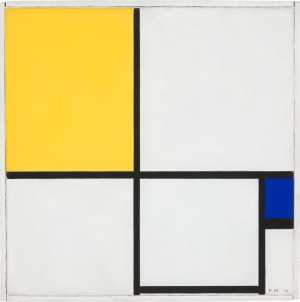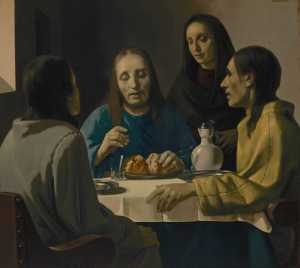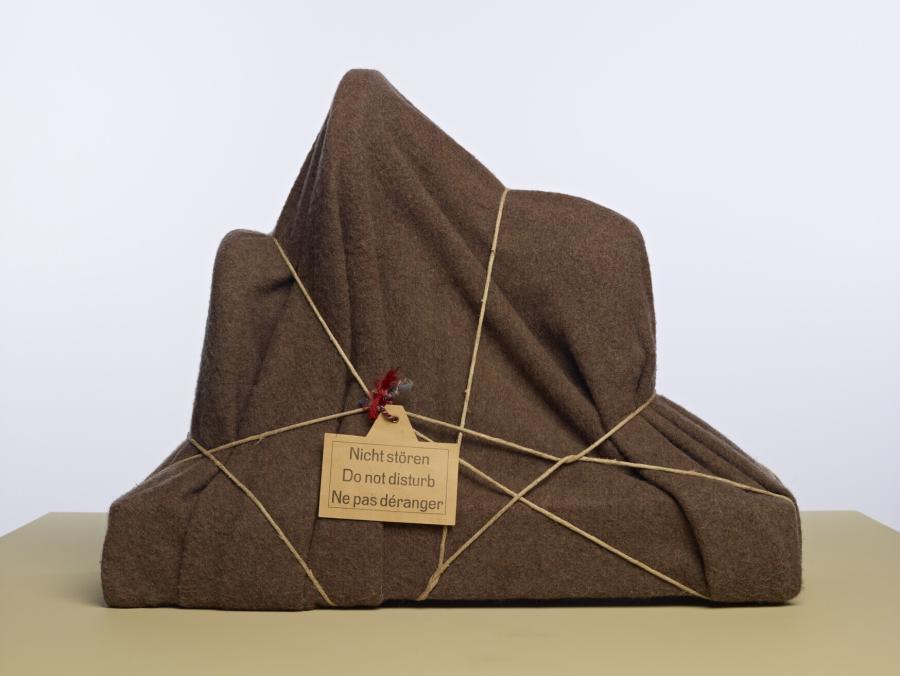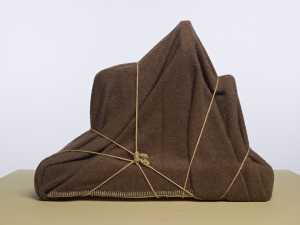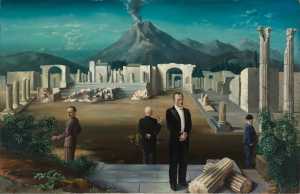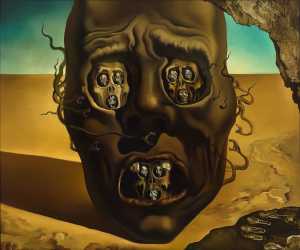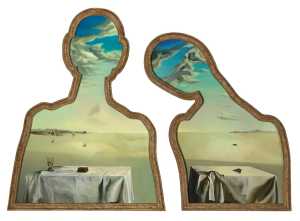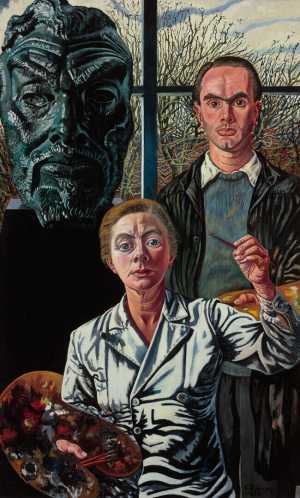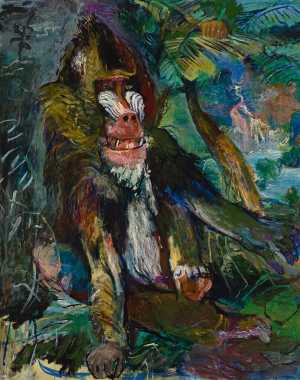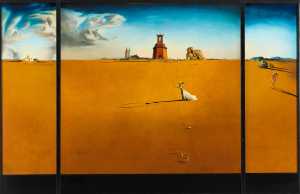Man Ray originally made this work for a photograph. The object was lost and in 1971 he made this new version. The mysterious object has an equally mysterious title, which refers to the author Isidor Ducasse, who worked under the pseudonym Comte de Lautréamont. He wrote one of the surrealists' favourite books: 'Les Chants de Maldoror' (1869). They saw this strange and unfathomable book as a kind of manifesto. It was a source of titles for several surrealist works.

Specifications
| Title | L'enigme d'Isidore Ducasse |
|---|---|
| Material and technique | Wood, fabric, rope, cardboard, metal, offset on paper and invisible object |
| Object type |
Sculpture
> Three-dimensional object
> Art object
|
| Location | This object is in storage |
| Dimensions |
Width 60 cm Height 45,5 cm Depth 24 cm |
|---|---|
| Artists |
Artist:
Man Ray
Publisher: Galleria Schwarz |
| Accession number | BEK 1491 (MK) |
| Credits | Purchased 1972 |
| Department | Modern Art |
| Acquisition date | 1972 |
| Creation date | in 1920 (1971) |
| Entitled parties | © Man Ray Trust / ADAGP, c/o Pictoright Amsterdam 2018 |
| Provenance | Artist’s proof from an edition of 10 copies and 3 artist’s proofs, published by Galleria Schwarz, Milan 1971; artist’s collection, 1972 |
| Exhibitions | Rotterdam/Paris/Humlebaek 1971-72; Berlin/London 1993; Antwerp 1994; London 1995; Drachten 1998; London/New York 2001-02; Paris/Düsseldorf 2002; London/Rotterdam/Bilbao 2007-2008; Rotterdam 2013-14a; Rotterdam 2014b; Rotterdam 2017b |
| Internal exhibitions |
The Collection Enriched (2011) Brancusi, Rosso, Man Ray - Framing Sculpture (2014) Een paraplu, een naaimachine en een ontleedtafel. Surrealisme à la Dalí in Rotterdam. (2013) Alles kids (2016) De collectie als tijdmachine (2017) Collectie - surrealisme (2017) |
| External exhibitions |
Dal nulla al sogno (2018) Behind the Curtain. Concealment and Revelation since the Renaissance (2016) Surrealist Art - Masterpieces from Museum Boijmans Van Beuningen (2021) Dalí, Magritte, Man Ray and Surrealism. Highlights from Museum Boijmans Van Beuningen (2023) A Surreal Shock – Masterpieces from Museum Boijmans Van Beuningen (2021) A Surreal Shock. Masterpieces from Museum Boijmans Van Beuningen (2023) IMAGINE! 100 Years of International Surrealism (2024) Only the Marvelous is Beautiful (2022) |
| Research |
Show research Digitising Contemporary Art Show research A dream collection - Surrealism in Museum Boijmans Van Beuningen |
| Literature | New York/Los Angeles/Chicago 1968, p. 31, fig. 32; Rotterdam/Paris/Humlebaek 1971-72, p. 144, cat. no. 143; Munich 1973-74, p. 203, cat. no. 81; Penrose 1975, p. 178; Schwarz 1977, pp. 283-84; Man Ray 1980, pp. 180-181, cat. no. 6; Man Ray/Martin 1983, cat. no. 27; Drachten 1998, cat. no. 20; London/Rotterdam/Bilbao 2007-08, pp. 262-63, cat. no. 5; Rotterdam 2007, pp. 36-37; Kamien-Kazhdan 2012, p. 109; Rotterdam 2014, pp. 208-09, cat. no. 42 |
| Material | |
| Object | |
| Technique |
Offset print
> Mechanical
> Planographic printing
> Printing technique
> Technique
> Material and technique
|
| Geographical origin | The United States of America > North America > America |
Do you have corrections or additional information about this work? Please, send us a message
Entry catalogue Digitising Contemporary Art, A dream collection - Surrealism in Museum Boijmans Van Beuningen
Author: Marijke Peyser
In May 1914 the American artist Man Ray married the Belgian poet Adon Lacroix (pseudonym of Donna Lecoeur). The couple went to live in the United States. Lacroix worked extremely precisely when furnishing their house in Ridgefield, New Jersey: ‘She carefully took the books out of the boxes. Sometimes she would read a passage aloud; sometimes she would translate a poem by Mallarmé or Rimbaud into English. The works of Apollinaire and Baudelaire emerged. She also read a passage from Les chants de Maldoror by Lautréamont.’[1] This book by the Comte de Lautréamont (pseudonym of Isidore Ducasse) made a particular impression on Man Ray, who recognized himself in the circumstances of the protagonist. Mervyn, the hero, is a pure and divinely beautiful child who makes every effort to extricate himself from his parents and his surroundings. In his quest for freedom Mervyn is pursued by Maldoror, the essence of evil. In the book Mervyn’s beauty is likened to the chance meeting of a sewing machine and an umbrella on a dissecting table.[2] This phrase had been a great source of inspiration for the Surrealists. Although little was known about Ducasse’s life and work in the years after the First World War, the writer was not unknown to André Breton and Philippe Soupault, the leaders of the fledgling Surrealist movement. Breton described Ducasse as the forerunner of Dada and Surrealism, and reprinted Ducasse’s Poésies in the avant-garde magazine Littérature in 1919.[3]
In July 1921 Man Ray crossed the Atlantic: he left the country of his birth and settled in Paris. When he arrived, his friend and fellow artist Marcel Duchamp was waiting for him. He provided him with somewhere to stay and took him along to the Café Certa, where he was welcomed by the Dadaists and later Surrealists Breton, Louis Aragon, Paul Éluard, Soupault and Jacques Rigaut.[4] Even before he went to Paris, Man Ray made an object that consisted of a sewing machine wrapped in a blanket and tied up with string, L’énigme d’Isidore Ducasse. Although the ‘enigma’ is easy for connoisseurs of Ducasse’s work to solve, the work retains a certain mysteriousness and arouses disquieting associations. In 1971 the gallery owner Arturo Schwarz, who had also taken the initiative for the ‘multiples’ of Duchamp’s readymades, had an edition of ten copies and three épreuves d’artiste made. Museum Boijmans Van Beuningen’s copy is the only one with the label ‘Do not disturb’, which Man Ray had taken from a hotel room and added to the work.[5] He repeated the device of tying up an object in Vénus restaurée, another work in the museum’s collection.
Footnotes
[1] Baldwin 1988, p. 37.
[2] Lautréamont/Mano 1938, chant VI, 1, p. 256.
[3] Breton was the editor-in-chief of this paper, see New York 2009a, p. 51.
[4] Baldwin 1988, p. 82, says that Man Ray arrived in Paris on 22 July 1921. Penrose 1975, p. 66, wrote that Man Ray arrived there on 14 July.
All about the artist
Man Ray
Philadelphia 1890 - Parijs 1976
The American artist Emmanuel Radnitzky, who would call himself Man Ray, began his career as engraver and advertising designer. In New York he got to know the...
Bekijk het volledige profiel

